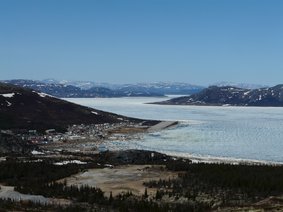Nain, Nunatsiavut

Year(s) Funded: 2013-2014
Topic Area: Adaptation Planning Contact: Tom Sheldon, Nunatsiavut Government Partners: Nunatsiavut Government, Nain, Hopedale, Makkovik and Rigolet Inuit Community Governments, Nain Research Centre, Memorial University, Trent University, Government of Newfoundland and Labrador, Canadian Mortgage and Housing Corporation, FoTenn Planning and Urban Design Website: http://nainresearchcentre.com/research-projects/the-sustainable-communities-initiative Title: InosiKatigeKagiamik Illumi: Healthy homes in Nunatsiavut
Action: Fieldwork for a housing risk assessment involving the communities of Nain, Hopedale and Makkovik was completed in fiscal year 2013-14. This risk assessment examined and clarified the problems and issues (and root causes) that are plaguing Nunatsiavut’s current housing stock. It identifies factors that are leading to premature housing failure in the context of the local environment, changing climatic conditions and community characteristics. With support from the Nunatsiavut Government, Inuit Community Governments, and community residents, a team of architects and engineers carried out an in-depth survey that included a thorough visual inspection, a blower door test and an infra-red scan to assist in measuring the energy efficiency of each home. The assessment included architectural, airtightness and thermal imaging, geotechnical, structural, mechanical and electrical components. In most cases, the occupants of houses also shared personal insights on problem areas in the houses with the project team. Results: Housing themes and concerns identified by communities and the Working Group that will shape Strategy development include: overcrowding, homelessness/couch surfing, repair requirements, health effects on children, individuals and families, funding, capacity and cost, community footprint and available building land, energy security, infrastructure integrity, healthy and safe environments, affordable housing, housing delivery models, mould, water systems (flooding and freezing), air quality and dust, erosion, cultural appropriateness and housing design. A participatory community-driven housing design process called a “charette” was also held in Nain. This was a participatory process and the first time community members have been actively engaged in discussing housing challenges and preferences related to designs. A separate report entitled “Nunatsiavut Housing Design Charrette – final” was created and includes important cultural values informing the design. Outputs: Designs for culturally relevant, affordable, energy-efficient, climate-adapted housing were created. The project used this project to secure $1M+ in funds necessary for a prototype multi-unit, climate adapted dwelling to be built in Nain. |
